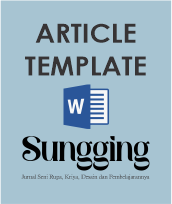Student experiences in art Learning based on creative pedagogy
Pengalaman mahasiswa dalam seni rupa berbasis pedagogi kreatif
DOI:
https://doi.org/10.21831/sungging.v4i1.87476Keywords:
Ekspresi diri, Self expression, Fenomenologi, Phenomenology, Pedagogi kreatif, Creative pedagogy, Art Education, Pengalaman mahasiswa, Student experienceAbstract
This study examines the experiences of fourth-semester Art Education students with creative pedagogy-based art learning. Using a phenomenological approach, data were collected through in-depth interviews with four participants in the Videography course. Thematic analysis revealed that creative pedagogy facilitates freedom of expression, the utilisation of imagination, and the exploration of personal style. Students reported deeper emotional and reflective engagement in learning, along with enhanced artistic identity development through autonomous selection of media, themes, and techniques. Significant differences were noted compared to conventional instruction's rigid, technical approach. Thus, creative pedagogy proves relevant for Art education, supporting character development and students' readiness in confronting the challenges of contemporary art and the demands of the creative industry.
_______________________________________________________________________________
Penelitian ini mengeksplorasi pengalaman mahasiswa semester IV Pendidikan Seni Rupa dalam pembelajaran seni berbasis creative pedagogy. Metode fenomenologi digunakan dengan wawancara mendalam terhadap empat partisipan mata kuliah Videografi. Hasil analisis tematik menunjukkan pendekatan ini memfasilitasi kebebasan berekspresi, pemanfaatan imajinasi, dan eksplorasi gaya personal. Mahasiswa merasa lebih terlibat secara emosional dan reflektif, serta mampu mengembangkan identitas artistik melalui pemilihan media, tema, dan teknik secara mandiri. Perbedaan signifikan terlihat dibanding pembelajaran konvensional yang lebih kaku dan teknis. Dengan demikian, creative pedagogy relevan diterapkan dalam pendidikan seni untuk mendukung pengembangan karakter dan kesiapan mahasiswa menghadapi tantangan seni kontemporer dan industri kreatif.
References
Ambarwati, D. R. S., Wulandari, D., Isa, B., Astuti, E. P., & Suardana, I. W. (2023). Museum-based learning for creativity: Indonesian and Malaysian teachers’ expectation vs reality. Humanities, Arts and Social Sciences Studies, 316–326. https://doi.org/10.14456/hasss.2023.29
Davies, D., Jindal-Snape, D., Collier, D., Digby, R., Hay, P., & Howe, A. (2013). Creative learning environments in education: A systematic literature review. Thinking Skills and Creativity, 8(1), 80–91. https://doi.org/https://doi.org/10.1016/j.tsc.2012.07.004
Hendri, Z. (2022). Promoting creative, imaginative learning for fine art education students in the 21st century. Imaji, 20(2), 140–145. https://doi.org/https://doi.org/10.21831/imaji.v20i2.52365
Hendri, Z., & Wulandari, D. (2022). Seni rupa anak & pembinaannya: Perspektif wacana kreativitas dan pedagogi kreatif (I. Malebra (ed.); 1st ed.). Cantrik Pustaka.
Nasir, A., Nurjana, Shah, K., Sirodj, R. A., & Afgani, M. W. (2023). Pendekatan fenomenologi dalam penelitian kualitatif. INNOVATIVE: Journal Of Social Science Research, 3(5), 4445–4451.
Nurazijah, M., Laila, S., & Rustini, T. (2018). Pendekatan Berdiferensiasi pada Pembelajaran IPS sebagai Bentuk Internalisasi Konsep Merdeka Belajar. ACADEMIA: Jurnal Inovasi Riset Akademik, 2(3), 119–127. https://doi.org/https://doi.org/10.51878/academia.v2i3.1447
Nurrita, T. (2018). Sarana Pembelajaran Untuk Meningkatkan Hasil Belajar. ACADEMIA: Jurnal Inovasi Riset Akademik, 2(3), 119–127. https://doi.org/https://doi.org/10.51878/academia.v2i3.1447
Panggabean, A. (2024). Kreativitas Dan Kritis Dalam Pendidikan Seni di Sekolah dan Keluarga. Jurnal Ilmu Kependidikan, 5(1), 181–193. https://doi.org/https://doi.org/10.51622/vsh.v5i1.2361
Pentury, H. J. (2017). Pengembangan Kreativitas Guru dalam Pembelajaran Kreatif Pembelajaran Bahasa Inggris. Jurnal Ilmu Kependidikan, 4(3), 265–272.
Sawyer, R. K. (2024). Explaining Creativity: The Science of Human Innovation. https://doi.org/https://doi.org/10.1093/oso/9780197747537.001.0001
Ubaidillah, & Hapudin, M. S. (2023). METODE EKSPRESI BEBAS TERHADAP KREATIVITAS MENGGAMBAR SISWA KELAS IV PADA MATA PELAJARAN SENI BUDAYA DI SD NEGERI PASIR AWI KABUPATEN TANGERANG. 9(2), 17–23.
Widiastuti, A., Suriatna, N., Disman, N., & Nurbayani, S. (2022). Proceedings of the 9th International Conference on Education Research, and Innovation (ICERI 2021). In Proceedings of the 9th International Conference on Education Research, and Innovation (ICERI 2021) (Issue August 2023). Atlantis Press SARL. https://doi.org/https://doi.org/10.2991/978-2-494069-67-1
Wirachman, R., & Kurniawati, I. (2023). Studi Deskriptif Model Pembelajaran Role Playing Berlandaskan Teori Social Learning Berbasis Pedagogik Kreatif. Inventa, 7(1), 37–49. https://doi.org/https://doi.org/10.36456/inventa.7.1.a6996
Wulandari, D. (2019). Advantages and challenges of the open-ended approach in nurturing creativity. In K. Astuti, G. McPherson, B. Sugeng, N. Kurniasari, T. Herawan, C. Drake, Ashadi, E. Retnowati, & A. C. Pierewan (Eds.), Proceedings of 21st Century Innovation in Music Education (INTERCOME 2018) (pp. 468–474). Routledge. https://doi.org/10.1201/9780429024931






